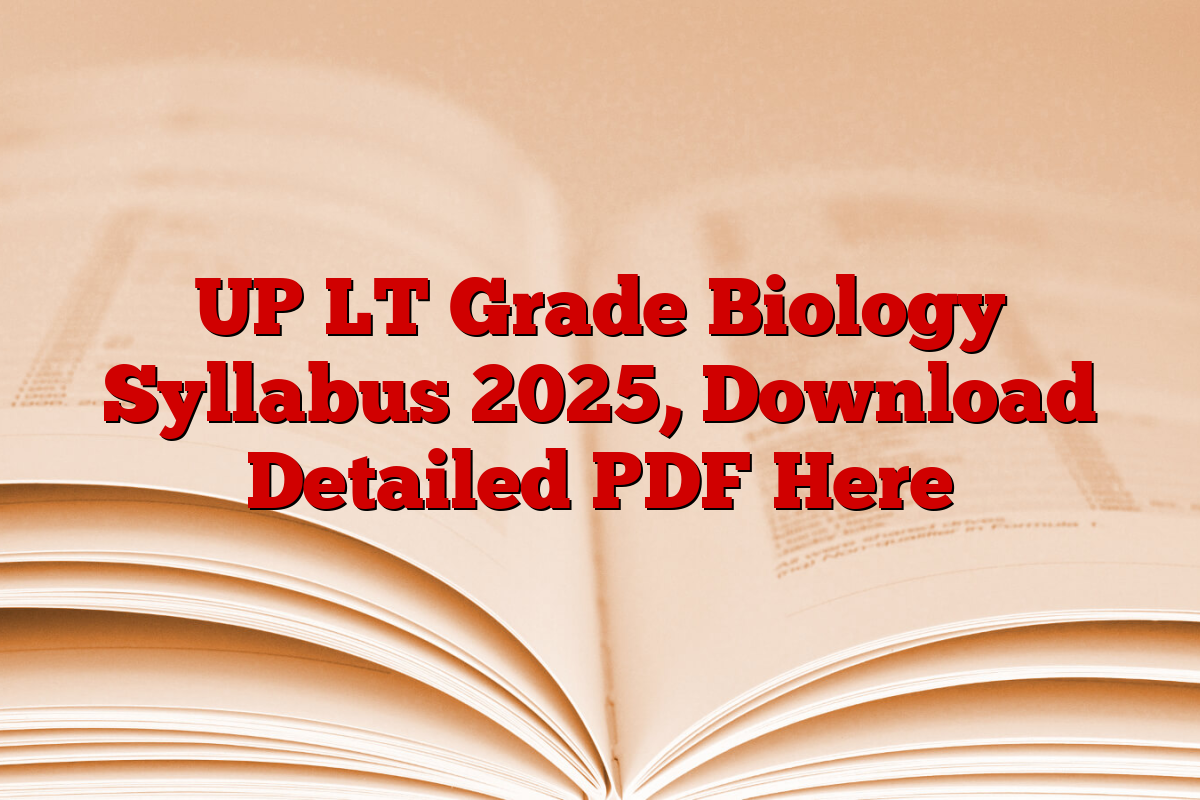UP LT Grade Biology Syllabus 2025 has been officially released, and it should be read for each aspiration preparing for this highly competitive teaching recruitment exam. Whether you are visible for the first time or returning with more attention, knowing the exact course gives you a clear direction. This is not just about studying, but how to reach your preparation smartly.
Thousands of vacancies are offered with the examination and being held after years of delay, 2025 is the golden year to crack it. But to be successful, you have to align your preparation with the official course and exam pattern. Let’s dive deeply in UP Lieutenant Grade Biology Syllabus 2025 and help download the official PDF version for structured prep.
UP lieutenant grade biology syllabus 2025
Understanding UP LT grade biology course is not optional; This is necessary. It shows what will be asked in the exam, the scope of each subject, and helps you prioritize high-loving subjects. Without clarity on the course, candidates often waste time on irrelevant areas or remember important people. With covering both zoology and botany, the course provides a balanced challenge for each biology bachelor’s bachelor’s post in Uttar Pradesh. Detailed LT grade syllabus acts as a blueprint for your study, giving you:
- Identify high scoring themes
- Plan the plan amendment program effectively
- Avoid unnecessary subjects
- Create confidence with targeted preparation
UP LT Grade Biology Exam Pattern 2025
UP LT Grade Teacher Exam 2025 will be held in two phases: Prelims and Main. In the following section, candidates will get a detailed examination pattern for both prelims and men’s exam.
UP LT Grade Prelims Exam Pattern 2025
| Exam pattern for UP LT Grade Prelims Examination | |
| Exam name | UP lieutenant grade teacher |
| question paper | One (purpose type) |
| Total Questions | 150 (30 General Studies + 120 Main/Optional Topics) |
| Alternative subject | biology |
| total marks | 300 (each question takes 2 marks) |
| Duration | 2 hours |
| Negative marking | Yes, 0.33 marks are cut for each wrong answer. |
| Merit mark | 35% for SC/ST and 40% for others |
Note: If many answers are selected, it is considered wrong even when it is correct. There is no fine without any question.
UP LT Grade Mains Exam Pattern 2025
| Exam pattern for main exam | |
| Eligibility | Only candidates who qualify for preliminary examination |
| question paper | One (descriptive/traditional type) |
| Total Questions | 20 questions (divided into 2 sections) |
| One segment | 10 short answer questions (125 words each, 8 digits each) = 80 marks |
| Section B | 10 long answer question (200 words each, 12 digits each) = 120 marks |
| total marks | 200 |
| Duration | 3 hours |
| Compulsory question | All questions are mandatory |
| Merit mark | 35% for SC/ST and 40% for others |
UP LT Grade Biology Syllabus 2025: Full Breakdown
There is a subject-wise observation of what you need to cover while preparing for UP LT grade biology. Mainly, candidates are required to study zoology and botany to cover the biology courses for the UP LT Grade Examination.
UP lieutenant grade biology syllabus for zoology
| UP lieutenant grade syllabus for zoology | |
| Classification and general characteristics |
|
| Representative creatures and life cycle |
|
| Applied zoology subject |
|
| Cell biology and genetics |
|
| Development and ecology |
|
| Human physiology |
|
| Organism |
|
| Fetology |
|
LT grade biology courses for botany
| Lieutenant Grade Syllabus for Botany | |
| Microbiology and lower plant |
|
| Classification of angiosoporm |
|
| Body structure |
|
| Economic botany |
|
| Fetology |
|
| Sitogenic |
|
| plant Physiology |
|
| Organism |
|
| Ecology and Environment |
|
| plant Pathology |
|
| Molecular biology and biotechnology |
|
UP Lieutenant Grade Biology Syllabus PDF
For candidates who like structured amendments, UP LT Grade Biology Syllabus is available for 2025 PDF download. It includes a complete course for both botany and zoology in an easy-to-up format.
Click here to download the official UP LT Grade Biology Syllabus PDF
sharing is Caring!

